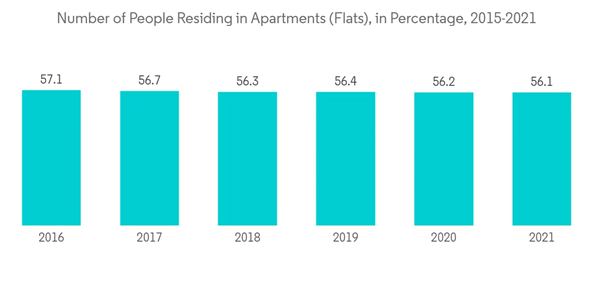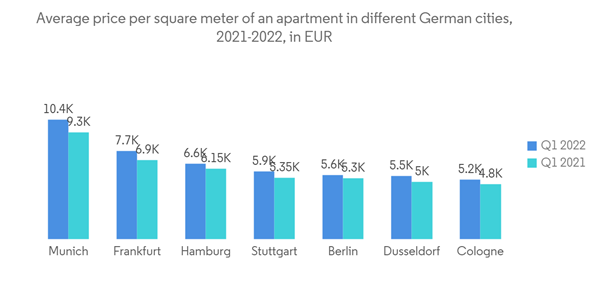Key Highlights
- The residential real estate market came to a halt due to the COVID-19 pandemic, as the government implemented lockdowns and citizens were forced to stay at home. Due to low borrowing rates, a lackluster supply of new homes being built, and increasing demand from more than 1 million refugees, Germany's long-running housing price boom is still strong despite the global epidemic. This is a huge change in a nation where the housing market has always been incredibly steady.
- In 2021, the upward trend in home and apartment prices persisted. According to bulwiengesa, the overall indexes for home and apartment prices in the 126 cities that we track increased by around 6 to 7% from 2020, which is roughly in line with the rate of the years before.
- All four groupings, specifically newly constructed and existing condominium units and terraced homes, followed the average very closely. In the same way, as in the years before, rents also continued to climb, albeit at a slower rate. Re-let and new unit rents increased by around 3% and 4%, respectively. As a result, the initial gross rental returns for both new and existing properties fell to 3.1% and 3.7%, respectively.
- In the year leading up to Q1 2021, the price of apartments increased by 11.46% (or 9.61% when adjusted for inflation), which is a minor decrease from the 13.61% growth seen in Q1 2020. Apartment prices increased by 4.02% every quarter (2.1% inflation-adjusted).
- Inflation-adjusted new home prices increased by 5.73% and 1.63%, respectively, year over year and quarter over quarter. Price increases for existing homes were 14.73% (12.83% inflation-adjusted) year over year and 4.07% (2.15 inflation-adjusted) quarter over quarter.
- The fourth quarter of 2021 saw an increase in apartment prices of 12% on average, which was the highest rate of price growth since records began in 2000. Since the pandemic started, prices have risen. It climbed by 8.25% through Q3 2021, after experiencing Y-o-Y increases of 8.38% in Q2 2021, 7.95% in Q1, 8.8% in Q4, and 7.38% in Q3 2020.
- Berlin, the capital of Germany, is the seventh-most populous city in the EU. The city's young population and expanding status as a European center for the arts and media have helped the residential sector of the economy. Numerous prestigious universities, orchestras, museums, amusement parks, and other creative businesses are located there.
Germany Condominiums and Apartments Market Trends
Freehold apartments: Consistent demand maintains steady prices
Freehold apartment prices continued to rise until this spring, with a 10.3% increase in the first half of 2022 (HY1 2022: 4,095 per square meter vs. HY1 2021: EUR 3,713 per square meter (USD 3,964)). Asking prices in Germany and the vast majority of the towns and cities examined by Engel & Volkers plateaued starting in May 2022.The top 7 cities in Germany experienced moderate price drops in July compared to June, including Munich, Frankfurt, Düsseldorf, and Hamburg. On the other hand, asking prices in Berlin and Stuttgart saw modest gains of +0.4% in the capital and +0.7% in the Baden-Württemberg state capital.
Munich tops the list of the areas examined with an average price of EUR 10,067 per square meter (USD 10,747), followed by Frankfurt at EUR 6,918 (USD 7,386) per square meter and Hamburg at EUR 6,769 (USD 7,226) per square meter. Prices continue to hold steady at a high level because there are still few open listings available in many areas. Living space in urban areas is still in high demand.
Since there are still not enough freehold flats available and there is a significant population influx into the major cities, prices will continue to plateau and no significant downward corrections are to be anticipated.
According to Till-Fabian Zalewski, "Many buyer groups are demonstrating solid credentials in terms of equity, in the best areas in particular, suggesting that small price increases may still be witnessed in select locations. Engel & Völkers predicts modest price increases in desirable areas through the end of 2022 in more than a quarter of the 56 towns and cities studied.
Prices in German cities and towns are steady
While market activity has been active in recent years, residential real estate valuations in Germany have remained extremely constant. Real estate has also been shown to be resilient to crises. For instance, despite the pandemic, the transaction volume in 2021 was EUR 182.4 billion (USD 194.74 Billion) and increased by 11.7% from the year before.Prices in Germany's major cities are not anticipated to significantly decrease until the end of 2022, despite the recent increase in interest rates. In terms of supply, the recent fall in construction activity due to a lack of suitable land for development and increasing construction costs coincides with the more constrained demand for residential real estate.
Pressure on the rental market is increasing as some buyer's access to credit is becoming more difficult. In preparation for the upcoming winter, buyers are particularly interested in newly constructed homes and existing residences that have undergone energy-efficient renovations and installed contemporary heating systems. "The desire to possess a home of one's own continues to be in high demand.
According to Till-Fabian Zalewski, who emphasizes the importance of location: "Real estate, especially in very good locations, remains a crisis-proof investment - not least because competitive investment alternatives are lacking. The level of supply is still too low to meet demand, a fact that will more than compensate for the higher interest rates."
The average cost per square meter of newly built apartments increased across all major German cities between the first quarter of 2021 and the first quarter of 2022. Apartments were most expensive in Munich with the average square meter price as high as EUR 10.4 million (USD 11.10 Million). In Cologne,on the other hand, the average square meter price was EUR 5,200 (USD 5,552). According to the house price index, house prices in the country have risen steadily in recent years .
Germany Condominiums and Apartments Industry Overview
The Europe condominiums and apartments market is fragmented with the presence of a large number of local and regional players, as well as global players. The major players include Strabag AG, Leonhard Weiss Gmbh & Co. KG, Köster GmbH, Vivawest GmbH, Bremer AG and many others. The demand for affordable housing and multi-family residential real estate is driving the market and the existing players need to invest in this segment to sustain in the market. While local players can hold a good share of the market by investing in the market.Additional Benefits:
- The market estimate (ME) sheet in Excel format
- 3 months of analyst support
This product will be delivered within 2 business days.
Table of Contents
Companies Mentioned (Partial List)
A selection of companies mentioned in this report includes, but is not limited to:
- Strabag AG
- Leonhard Weiss Gmbh & Co. KG
- Koster GmbH
- Vivawest GmbH
- Bremer AG
- Hochtief Solutions AG
- Goldbeck Nord Gmbh
- BPD Immobilienentwicklung GmbH
- Vivawest Wohnen GmbH
- Goldbeck Bauelemente Treuen Gmbh
- GAG Immobilien AG
- ZECH Hochbau AG*










